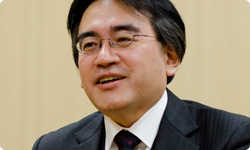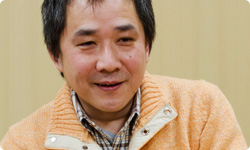Thanks very much for joining me today, Sonobe-san. Now, you and I are part of the same generation, and it feels to me like we’ve both been making games together right from the very early days of the video game industry.
That’s right. Back when you were working at HAL Laboratory1 we used to visit spas together, didn’t we? (laughs)1. HAL Laboratory, Inc.: A software developer that has worked on the Kirby and Smash Bros. series, among others. Nintendo president and CEO Satoru Iwata worked as president for HAL Laboratory.
Ah, yes. We went to the Isawa hot springs, didn’t we? (laughs)
Indeed, it was the Isawa hot springs. (laughs)
Ah, that takes me back... But we’re here today to discuss Nintendo Pocket Football Club.
Right.
At the same time, it would seem a shame not to ask you about some of your previous work. In any case, I’m very much looking forward to today’s discussion.
As am I.
Now, over the years you’ve taken the sports simulation genre as your foundation and developed a lot of innovative games about baseball, horse racing and football.
Yes, that’s right.
I wonder if you could tell us about your introduction to the world of video games.
Well, naturally it all started with Breakout2. Arcades back then had nothing but pinball machines, so when that game appeared... well, it made quite a splash. 2. Breakout: An arcade game developed by Atari Inc. (now Atari Interactive) in which the player uses a paddle to hit a ball and break the blocks at the top of the screen. It first appeared in Japan in the late 1970s.

In arcades at the time, you would only find mechanical game machines. To suddenly have something with a television monitor was a completely new development in entertainment.
That’s right. And then you’d watch your 100 yen coins disappear in a flash...
You’d have a pile of 100 yen coins, and before you knew it, they’d all be gone...
That’s right! (laughs) But I was a secondary school student back then, so I didn’t have two-100 yen coins to rub together. Instead, I would just stand and watch everyone else playing.
Ah, yes! (laughs)
You’d get players who were so good that the game would just go on and on. But there was something about just watching that was fun.
Back then, you’d get a whole crowd of people gathered around good players, wouldn’t you?
That’s right.
So when you had your first experience of video games back as a secondary school student in an arcade, what impression did you get?
Well, I remember that back then I thought video games in the arcade were entirely hardware-based.
So you didn’t know much about software? Well, it’s true that software was really only fully utilised in video games from around the time of Space Invaders3.3. Space Invaders: An arcade game released in 1978.
That’s right. But back then, I wasn’t even aware of the existence of software. Then I began studying mechanical engineering, and soon after entering university, I bought a programmable calculator4.
Actually, I owe my earliest experience of game programming to the programmable calculator.4. Programmable calculator: A calculator that could be programmed to carry out complex operations automatically. It was very simple, with a display that could only show one line of alphanumeric characters. The one used by Mr Iwata could only display numbers.
Ah, is that right? (laughs) I was able to program simple games on my calculator, but if you’d asked me what I thought software was, I would have said that it was that high-pitched screeching sound...
Ah yes, you’re talking about the programs at the time that were saved on cassette. This meant that the programs on the cassette were actually audible, with that piercing, screeching sound.
Well, because I didn’t know what software actually was, I thought it really was that sound.
(laughs)
At that time, I was getting really into mahjong, and became hooked on a game called Janputer5.
Ah, yes. Janputer was a huge craze, wasn’t it?5. Janputer: A Japanese arcade game based on the classic Chinese game mahjong, released in 1981.
In that game, the computer would stack up mahjong tiles in all sorts of combinations, and at first I couldn’t understand how it did it. It was at that point that I realised that this was all based on software.
So would you say at that point that the distance separating you and computers suddenly narrowed?
Yes, I would say so.

So although you were originally something of an outsider as far as computers were concerned, you ended up completely dedicated to creating video games. I wonder what it was specifically that brought about this change.
Well, as a child, I had always enjoyed inventing games. This was the era before computers, so I’m talking about board games and things like that...
What kind of games were they?
Well, I’d draw a baseball stadium on a piece of paper, for example. Then I’d use a piece of a pencil eraser as the ball, and flick it with my finger. Depending on where it landed, I’d see whether it was a strike, a two-base hit, or whatever. I’d make games like that.
So it was a homemade baseball board game. I actually made one myself, back when I was a kid. (laughs)
I remember I’d note down all the batting averages and other stats, then go home and tot them all up. I’d announce the results the next day.
So even when you were a child, you were something of a statistical wizard.
Well, I wouldn’t go quite that far. I remember I found doing all the sums by hand to be a real pain, so I bought a pocket calculator and was really relieved by how much easier it made things.
Normally, if you were playing a homemade baseball board game, you wouldn’t expect there to be anything more than maybe a scoreboard.
I suppose not. But I remember really enjoying seeing everyone’s reaction when I announced the top ten batting averages. It was just like when Breakout came out and I would find it really enjoyable to just watch other people play, rather than playing myself.
So for you, it was more fun to watch other people playing, and see the reaction of the other spectators, than it was to take control of the game and play yourself.
Yes, that’s right, and although I wasn’t playing, I’d find myself joining in all the same, shouting out “Look out! Over there!” or whatever.
Ah, I see. So it sounds like this preference for watching other people play, which forms the cornerstone of your approach to video game design, was already in place back then.
Yes, you’re right.
Just out of interest, what was the first computer you ever owned?

It was the FM-76. I actually had my heart set on an FM-87, but they were really expensive...6. Fujitsu Micro 7: An 8-bit home computer released by Fujitsu in Japan in 1982. It was designed as a more affordable version of the FM-8.7. Fujitsu Micro 8: The first 8-bit home computer released by Fujitsu. It was released in Japan in 1981.
Yes, the FM-8 was pricey, wasn’t it?
But then the FM-7 came out, and suddenly you could get hold of a computer for around half the price of the FM-8.
So you thought “This is what I’ve been waiting for!” and bought one.
That’s right.
Now, I’m assuming that you started out without any knowledge of home computers. How did you learn how to use your new computer?
Well, I didn’t do any formal study. From the first day I bought the FM-7, I would just sit there typing in the programs you’d find listed in computer magazines.
Back then, you’d have no choice but to just type in the whole program.
By doing that, I managed to teach myself BASIC8. The FM-7’s CPU really wasn’t used by many other computers, but this actually came in handy when I started programming on the Famicom later on. 8. BASIC: A standard programming language.
Ah, yes. The FM-7 had a 6809 CPU9, which had a lot in common with the Famicom’s 650210 in terms of its make-up. There was definitely an affinity between the two.9. 6809: An 8-bit microprocessor CPU released by Motorola Inc. (now Motorola Mobility LLC) in 1979.10. 6502: An 8-bit CPU announced by MOS Technology, Inc. in 1975. It suddenly became well known when it was used for the Apple II, but it did not see widespread use in Japan as a CPU for personal computers. The Famicom’s CPU is a modified version of the 6502.
Indeed there was.
© 2024 Nintendo.